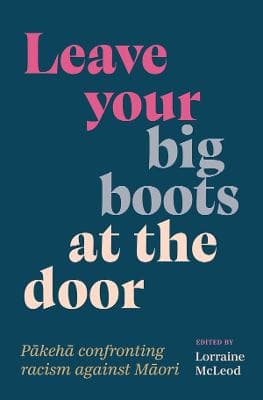Review: Leave Your Big Boots At The Door, by Lorraine McLeod
Reviewed by David Veart
A posting pops up on a Facebook archaeology page I follow. ‘We are not in Aotearoa, we are in New Zealand, you dumb arse,’ says an old bloke in gumboots, leaning on a shovel, giving his opinion on our country’s name. Then, the first headline I see that morning: ‘While attention has been focused on the Treaty Principles Bill, the government has quietly begun reviewing Treaty of Waitangi clauses in 28 pieces of legislation.’ Reviewing with intent to remove the Te Tiriti clauses not strengthen them. The new history curriculum is to be ‘rebalanced’, guess in which direction? It is coming at Māori from all directions.
How do those of us who have a broader vision for Aotearoa New Zealand, Pākehā, Tangata Tiriti, deal with the anti-Māori actions of our families, our neighbours, our government and our history? Leave Your Big Boots At The Door: Pākehā confronting racism against Māori contains a series of short memoirs, interviews and essays by 17 Pākehā who have for years fought against the world view espoused by the old bloke in the gumboots and the inherent racism of many of our institutions. They describe their experiences of racism in the institutions they deal with and the personal responses they have received in the process.
The contributors include some well known names: Pat Snedden, Denis O’Reilly, Richard Shaw, Andrew Judd, and others we should know better. Some of the situations and the actions taken to redress the racism encountered stand out; I found Dr Anne Milne’s description of working in education in South Auckland particularly illuminating and having taught in Ōtara in the 1970s there was much that was familiar. Because many of these people have been active for years, there are memories of events and actions of which the details have been dulled by time. Mitzi Nairn cites the Hunn Report of 1960 as an early influence. This document prepared at the instigation of secretary for Māori Affairs concluded that most previous policy toward Māori had failed but then proposed assimilation as an alternative–one group of failures sadly succeeded by another.
It is this institutional racism that has engaged the activism of many of the contributors to this book. Schools, universities, the police force, medicine, the church and the law all get a mention. Educator Rebecca Sinclair observes that this institutional and historic racism is so ingrained in us that we need to constantly interrogate our own behaviour. From personal experience I have found that while you can be aware of the institutional racism around you it is direct involvement that makes it real. I worked as an archaeologist in the Department of Conservation for many years, appearing in hearings and court cases backed by departmental lawyers and planners, but it was not until I began working with the people protecting Ihumaatao that the racist framework of this system became fully apparent. Whose heritage is the legislation trying to protect, who gets to decide what is important, and critically–what is heritage?
As well as the racism encountered as part of institutions the book examines the personal attacks directed at the authors. Opposition from the institutional world tends to be veiled in legalese and lacks the vitriol of personal responses. I received some of this during Ihumaatao: I was sent plenty of material about Hobson’s Pledge, and one of the kinder responses labelled me a ‘race traitor’. People in this book were called much worse. Perhaps not surprisingly it is those who stand up publicly who record the most abuse; Richard Shaw who has written of his family’s involvement at Parihaka quotes correspondents describing Māori as ‘subhuman cannibal savages.’ Andrew Judd, ex-mayor of New Plymouth and self described ‘recovering racist’ chronicles the abuse he received starting when a Māori ward was established in his city and while he says his decision not to stand for the mayoralty again was ‘multifaceted’ I imagine one of the facets was the very personal abuse he describes here.
Occasionally institutions let their masks slip and we can see what is really happening institutionally as well. Dr Rod Jackson describes the openly racist assessments received for an academic paper involving cardiovascular risk factors in different ethnic groups in Aotearoa New Zealand. All the anonymous assessors were professors of cardiology.
While the book has a useful introduction there is little analysis of the contributions. Some patterns emerge of their own accord, but a fuller examination of these would be valuable. The strength of this book is its immediacy. It comments on events as they are happening now, from people with a long history of anti-racist action. The other strength for Pākehā is that it is written by Pākehā, as one of the people at Ihumaatao said when I asked what would help, ‘Talk to Pākehā.’
In the words of Dr Heather Came, ‘to disrupt racism, we must keep talking to those who are experiencing it. But the people whose minds we have to change are Pākehā.’ This book might not change the minds of people like the bloke in the gumboots, but it may ease others into understanding the effects of racism. It also reassures Pākehā working in this area that they are part of something larger. We are not alone.
Reviewed by David Veart

